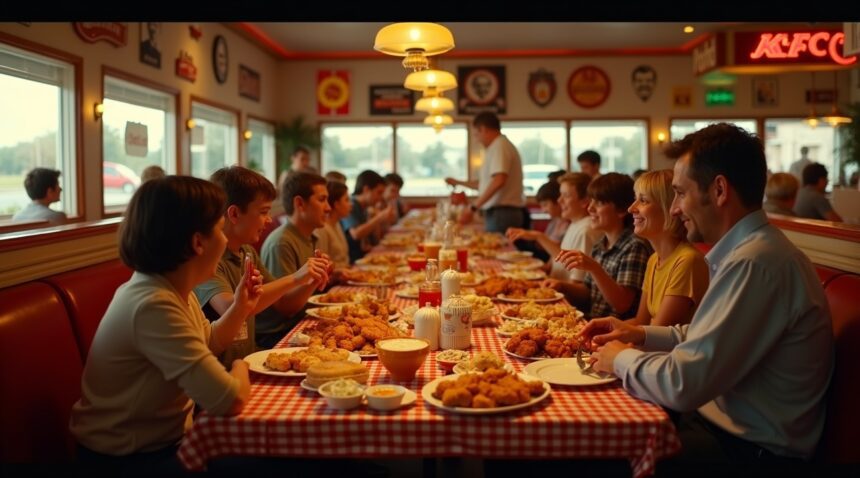Many Americans are discovering that KFC buffets still exist in select locations across the United States, despite most people assuming they disappeared years ago.
Key Takeaways
- KFC buffets offer unlimited servings of Original Recipe chicken, sides like mashed potatoes and coleslaw, salads, and desserts for typically $12-18 per person
- Most surviving buffet locations are found in Southern states including Tennessee, Kentucky, North Carolina, and Virginia, with one remaining location in Canada
- The buffet format declined due to changing health preferences, high operational costs, food safety challenges, and the COVID-19 pandemic
- Dedicated fan communities like the KFC Buffet Aficionados Facebook group maintain unofficial directories and organize road trips
- Japan maintains thriving buffets in Tokyo, Nagoya, and Osaka that feature unique items and require advance reservations
The Rise and Fall of KFC Buffets
KFC introduced buffet-style dining in the 1980s to compete with other family restaurant chains. These all-you-can-eat establishments centered around the brand’s signature Original Recipe chicken, accompanied by classic Southern sides, salads, and desserts. At their height, KFC operated hundreds of buffet locations, particularly in rural and smaller urban areas where family dining flourished.
For nearly two decades, the buffet format thrived. Customers appreciated its value and fixed pricing, while families enjoyed the variety of options and convenience. The self-service approach also benefited franchise operators by reducing staffing needs and increasing food turnover, especially during peak dining hours.
However, in the early 2000s, several factors began to erode this success. A growing focus on health and nutrition led to a decline in the popularity of buffets. Fast casual and to-go dining options became increasingly preferred by consumers. Operational costs, including food prices and insurance, climbed, cutting into profitability. The COVID-19 pandemic further accelerated their demise by introducing stringent health protocols and reduced dine-in traffic.
Current Locations and Geographic Distribution
Today, only 16-22 KFC buffet locations remain in operation, mostly clustered in the American South and Southeast. Tennessee leads with up to eight functional buffets. Kentucky, the brand’s origin state, retains three to four locations. North Carolina and Virginia each have two to three active buffets. Additional locations may persist in South Carolina, Georgia, and West Virginia.
These remaining buffets are typically situated in small towns or on rural highways, occupying older KFC buildings with spacious dining areas. A nostalgic ambiance draws regulars from the community and curiosity-seekers alike. Buffets along travel corridors attract truckers and road-tripping families who appreciate reliable, generous portions at a fair price.
What’s Still on the Menu
KFC buffets still highlight their classic Original Recipe chicken, offered in various cuts like drumsticks, thighs, wings, and breasts. Some locations offer Extra Crispy chicken as an alternative. Popular side dishes include mashed potatoes with gravy, coleslaw, macaroni and cheese, green beans, and corn. Regional variations such as biscuits with honey and potato wedges may also appear.
Most buffets also feature a modest salad bar with standard vegetables and dressings. Dessert options typically include soft-serve ice cream, cookies, or cakes. Beverages are usually purchased separately at standard KFC rates.
Pricing usually ranges from $12-18 per adult. Children and seniors often benefit from adjusted pricing tiers based on age or eligibility.
The Passionate Fan Community
A devoted base of fans helps keep the KFC buffet tradition alive through online communities. The KFC Buffet Aficionados Facebook group has over 15,000 members who share updates, reviews, and organize group visits. The group serves as an unofficial directory since KFC does not publish a formal list of buffet locations.
Members frequently share buffet photos, assess meal quality, and monitor closures or reopenings. Some take it further, mapping cross-country road trips to visit various buffets, treating the experience like a journey through fast-food history. Photography and memorabilia collecting — from signage to uniforms — also play central roles in the community’s culture.
International Success Stories
While American KFC buffets have largely dwindled, the concept thrives overseas. In Japan, for example, buffet restaurants in Tokyo, Nagoya, and Osaka have gained immense popularity. Visitors often need advance reservations as these locations use ticketing systems that limit occupancy and provide 80 to 90 minutes of dining time per session.
Japanese KFC buffets often include menu adaptations such as corn soup, rice-based dishes, and soft-serve ice cream to cater to local tastes. The focus on quality ensures regularly refreshed trays and a high-end experience compared to the traditional U.S. model.
Other countries, such as Australia and South Africa, also sustain KFC buffets, each with its own regional variations while preserving core elements that define the KFC buffet model.
Challenges and Future Outlook
Operational challenges continue to limit the growth and viability of KFC buffets. Food safety laws require vigilant oversight including frequent temperature checks, cleaning schedules, and food replenishment habits. This added complexity increases staffing and oversight needs.
Maintaining older equipment — like food warmers, buffet tables, and sneeze guards — adds to the financial strain. Many franchisees face daunting repair costs that deter continued buffet operations. Corporate discouragement and lack of promotional support from KFC hinder the sustainability of these unique outlets.
Liability insurance and increased premiums, particularly for food-based risks and slips and falls, also weigh heavily on owners. In many cases, the diminishing returns no longer justify the added risks and expenses.
Tips for Finding and Visiting KFC Buffets
- Join online communities like the KFC Buffet Aficionados for current buffet locations and reviews.
- Call local KFC branches directly to confirm buffet hours and availability.
- Plan visits around lunch hours — typically 11 AM to 3 PM — for the best food freshness and selection.
- Check payment methods ahead of time; some locations are cash-only.
- Be patient and friendly — staff often respond positively to special requests and inquiries about fresh items.
- Verify photo policies if you plan to document your visit. Respect staff preferences and atmosphere.
Whether you’re driven by nostalgia or just a love for fried chicken, the remaining KFC buffets offer a warm slice of American fast food history — if you’re willing to seek it out.
KFC’s Vanishing All-You-Can-Eat Secret: Only 16–22 Locations Remain Nationwide
I discovered that KFC’s all-you-can-eat buffets have become one of America’s best-kept dining secrets, with only 16 to 22 locations still operating across the entire United States. These rare gems offer everything a fried chicken enthusiast could want: unlimited servings of KFC’s famous Original Recipe chicken, crispy sides, fresh salads, and indulgent desserts.
The buffet concept once thrived at KFC locations before the 2000s, when dozens of franchises offered the all-you-can-eat experience. However, changing dining habits, increased food costs, and corporate restructuring have steadily reduced their numbers over the past two decades. Much like how Rush Hour 4 confirmed news surprises fans, the existence of these buffets continues to shock people who stumble upon them.
Finding these elusive locations presents a unique challenge since KFC corporate doesn’t maintain an official list or locator tool for buffet restaurants. Enthusiasts rely heavily on grassroots tracking methods, with the Facebook group ‘KFC Buffet Aficionados’ serving as the most reliable source for current locations. This dedicated community of fans shares updates, photos, and reviews while maintaining what amounts to an unofficial directory of active buffet sites.
What These Rare Buffets Actually Offer
KFC buffets operate as select franchise locations, meaning individual owners make the decision to offer this dining format. Customers typically find warming trays filled with:
- Original Recipe and Extra Crispy chicken pieces
- Hot Wings and popcorn chicken varieties
- Classic sides including mashed potatoes, gravy, and coleslaw
- Mac and cheese, green beans, and corn on the cob
- Fresh salad bars with multiple toppings
- Dessert options like cookies and parfaits
The pricing varies by location, but most buffets charge between $12 and $18 for adults, making them surprisingly affordable given the unlimited nature of the offering. Some locations also feature lunch and dinner pricing tiers, with slightly higher costs during peak evening hours.
I’ve noticed that these remaining buffets often exist in smaller cities and rural areas where foot traffic patterns differ from urban markets. Franchise owners in these locations find the buffet format attracts families, groups, and travelers who appreciate the value proposition of unlimited KFC favorites. The format also appeals to customers who want to sample multiple menu items without ordering individual pieces.
Social media discovery has become the primary way people learn about nearby KFC buffets, often through surprised posts from travelers who accidentally stumble upon them. Much like how Netflix announces surprise content that generates buzz, these buffet discoveries create viral moments among food enthusiasts.
The rarity factor has created almost cult-like status around remaining locations. Food bloggers and KFC superfans plan road trips specifically to visit active buffet sites, treating them as destination dining experiences rather than convenient fast-food stops. Some locations report customers driving several hours just to experience the all-you-can-eat format.
Corporate KFC hasn’t officially discontinued the buffet concept, but they don’t actively promote or support it either. This leaves individual franchise owners to maintain the format independently, which explains why locations can close or modify their buffet offerings without widespread notice. The lack of corporate oversight also means quality and selection can vary significantly between different buffet locations.
Several factors contribute to the continued decline of KFC buffets:
- Food safety regulations require constant monitoring of warming temperatures and frequent restocking.
- Labor costs increase since staff must continuously refresh items and maintain the serving area.
- Modern dining trends favor customization and speed over the traditional buffet experience, particularly among younger consumers who prefer quick service options.
Despite their dwindling numbers, the remaining KFC buffets represent a fascinating piece of fast-food history that continues to surprise and delight customers who discover them.
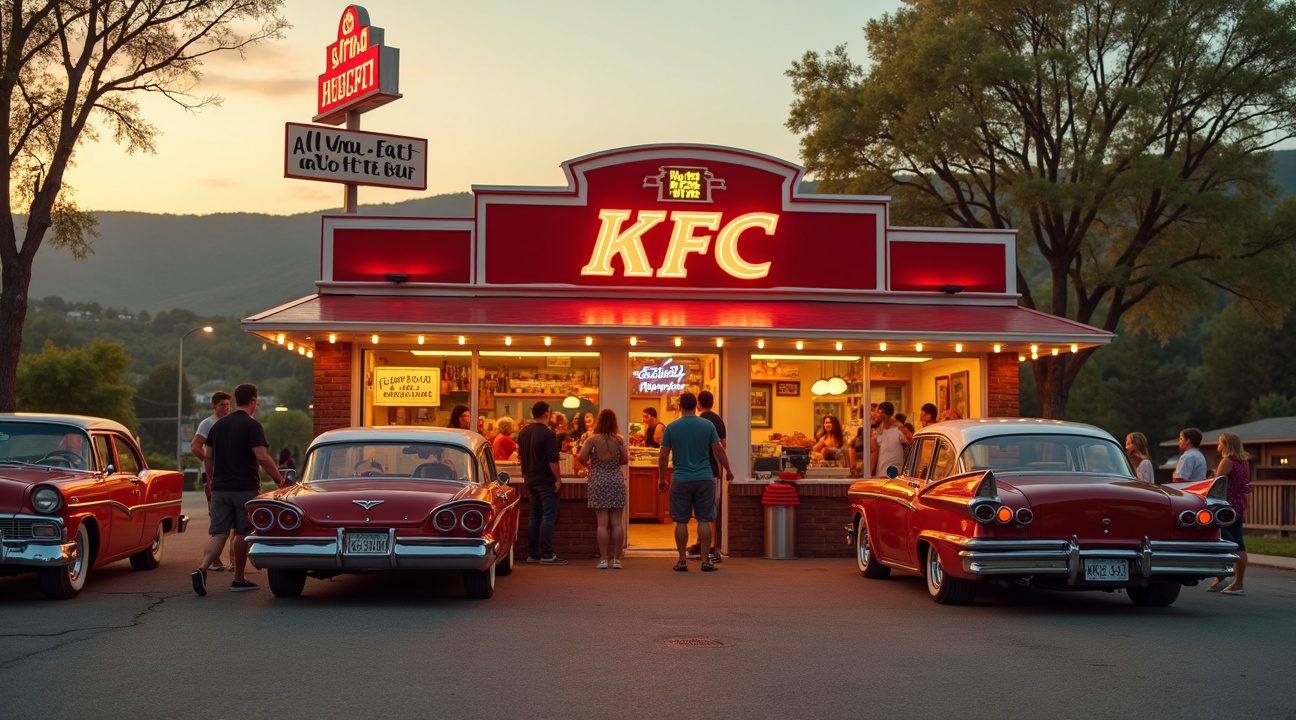
Hidden in the South: The Last Stand of America’s KFC Buffets
The surviving KFC buffets haven’t scattered randomly across America – they’ve concentrated in the South and Southeast, creating what I consider the final frontier of unlimited fried chicken dining. These remaining locations form a distinctive geographic pattern that tells the story of regional preferences and local franchise owner determination.
Tennessee stands as the unofficial capital of KFC buffet survival, with locations in Pigeon Forge and Sparta continuing to serve all-you-can-eat chicken to devoted customers. Kentucky, the birthplace of Colonel Sanders’ empire, maintains its buffet tradition in Louisville, while neighboring states carry the torch with locations in Waynesboro, Virginia, and Dunn, North Carolina. The buffet network extends through Mississippi, Oklahoma, Alabama, Missouri, and South Carolina, creating a Southern belt of unlimited chicken access.
International Outliers and Local Heroes
Beyond the American South, Canada holds perhaps the most remarkable KFC buffet story. The Weyburn, Saskatchewan location operates the country’s only remaining KFC buffet, a distinction earned through extraordinary local support. When the pandemic forced this buffet to close, community advocacy and customer loyalty brought it back – a rare victory in the declining buffet landscape.
Individual buffet revivals have become social media celebrations, generating significant online buzz and driving customer traffic. The Madisonville, Tennessee location exemplifies this phenomenon, where the return of buffet service sparked widespread coverage across food blogs and social platforms. These digital success stories demonstrate how passionate communities can influence corporate decisions and preserve beloved dining traditions.
Local franchise owners play crucial roles in buffet survival, often making personal commitments to maintain these operations despite corporate shifts away from buffet models. The geographic concentration in the South reflects both cultural dining preferences and the economic realities of buffet operation – these regions maintain sufficient customer demand to justify the higher operational costs.
Community support extends beyond simple customer visits. Local media coverage, social media promotion, and word-of-mouth recommendations create sustainable customer bases for these remaining locations. The phenomenon has reached entertainment industry attention, with food enthusiasts and content creators making pilgrimages to document these dining experiences, similar to how nostalgic entertainment properties capture devoted followings.
The buffet locations often become tourist destinations in their own right. Pigeon Forge, already a popular vacation spot, benefits from visitors seeking the complete KFC buffet experience alongside other attractions. These establishments have evolved beyond simple restaurants to become cultural landmarks representing a specific era of American fast-food dining.
Regional economic factors also influence buffet survival rates. Southern markets often feature lower operational costs and different labor dynamics compared to urban coastal areas, making buffet service more financially viable. The customer demographic in these regions tends to appreciate family-style dining experiences and value-oriented meal options.
Success stories like Weyburn demonstrate that corporate decisions aren’t always final. When local communities mobilize support and demonstrate sustained demand, franchise operators and corporate leadership sometimes reconsider closure decisions. Marketing campaigns highlighting these community efforts have proven effective in generating broader awareness and support.
The digital age has transformed how people discover and discuss these remaining buffets. Food bloggers document their experiences, creating detailed reviews and location guides that help other enthusiasts plan their visits. Social media platforms amplify these discoveries, turning regional dining options into national conversation topics.
Preservation efforts vary by location, with some communities organizing regular customer visits to maintain minimum traffic levels. Others leverage local tourism boards and chamber of commerce networks to promote their buffets as unique attractions. The success of these grassroots efforts suggests that determined communities can influence corporate dining strategies when they demonstrate consistent support and economic viability.

Japan’s KFC Buffet Paradise: Where the Dream Lives On
While American KFC enthusiasts discover that buffets once existed in their backyard, Japan maintains a thriving buffet culture that continues to draw crowds and create memorable dining experiences. Tokyo, Nagoya, and Osaka host buffet-style KFC locations that have become so popular they often require advance ticket purchases to manage demand.
Beyond Fried Chicken: Japan’s Unique Buffet Offerings
Japanese KFC buffets extend far beyond the traditional fried chicken experience that most people associate with the brand. These locations feature an impressive array of items that cater to local tastes and preferences:
- Corn soup that provides warmth and comfort alongside crispy chicken pieces
- Steamed potatoes prepared with Japanese culinary techniques
- Fresh salad options that balance the heavier fried items
- Soft serve ice cream for dessert
- Mini cakes that add a sweet finishing touch to the meal
- Region-specific specialties like soup curry in Osaka locations
This diverse menu demonstrates how KFC adapts its offerings to match cultural preferences while maintaining its core identity. Much like how Netflix announces new content tailored to different regions, these buffets showcase localized innovation within a global brand framework.
The Rarity Factor in Global Context
Despite their popularity in select Japanese cities, KFC buffets represent an incredibly small fraction of the brand’s global presence. As of 2024, KFC operates approximately 32,000 restaurants across 150 countries, making buffet locations exceptionally rare gems within this massive network.
Major markets tell a similar story of scarcity. China, despite being one of KFC’s largest markets, offers buffets only as rare exceptions among thousands of standard locations. The United States, where the brand originated, has seen its buffet culture largely disappear over the past decade. Similarly, the United Kingdom maintains just a handful of buffet locations scattered across the country.
This scarcity creates a unique phenomenon where buffet experiences become almost pilgrimage-worthy for dedicated fans. Japanese locations benefit from this exclusivity, drawing both locals and tourists who specifically seek out these dining experiences. The ticket system implemented at popular locations further reinforces their special status and helps manage overwhelming demand.
Food service industry trends have generally moved away from buffet formats, particularly following global health concerns that emerged in recent years. However, Japan’s continued success with this model shows that when executed properly and adapted to local preferences, buffets can still thrive in specific markets.
The contrast between Japan’s buffet success and their decline elsewhere highlights how cultural factors influence restaurant concepts. Japanese dining culture embraces variety and seasonal offerings, making the buffet format a natural fit. Additionally, the social aspect of sharing meals and trying different items aligns well with local customs.
For travelers and KFC enthusiasts, these Japanese locations represent something truly special – a chance to experience the brand in a completely different context. The combination of familiar favorites with uniquely Japanese additions creates an experience that can’t be replicated anywhere else in the world. Whether someone’s interest stems from nostalgia for American buffets or curiosity about international variations, Japan’s KFC buffets offer a distinctive culinary adventure that continues to draw crowds years after their introduction.
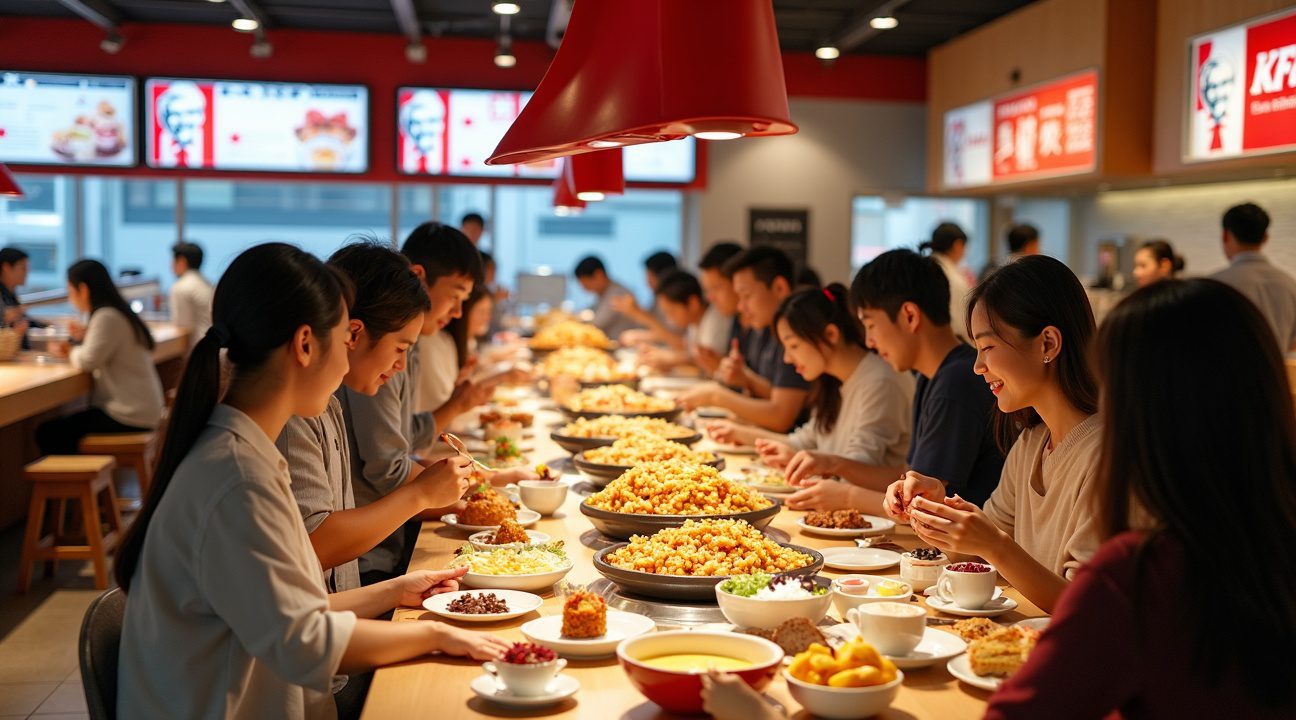
The Rise and Fall: Why America’s KFC Buffets Nearly Went Extinct
KFC buffets once represented the pinnacle of fried chicken indulgence, but their dramatic disappearance from the American dining landscape tells a story of shifting consumer preferences and business realities. I’ve observed how multiple factors converged to make these all-you-can-eat havens financially unsustainable for the Colonel’s empire.
Health Consciousness Reshapes Fast Food Preferences
The 2000s marked a turning point in American dining habits, with health consciousness becoming a driving force behind menu decisions. KFC recognized this shift early and began moving away from buffet offerings in favor of à la carte options that allowed customers more control over portion sizes. This strategic pivot aligned with growing demands for transparency in nutrition information and fresher menu items.
The company’s focus shifted toward streamlined operations that could deliver consistent quality while accommodating health-conscious consumers. Entertainment industry trends showed similar patterns of consumer preference evolution during this period. KFC’s decision to emphasize grilled chicken options and salads over unlimited fried chicken reflected broader industry changes that prioritized perceived health benefits over sheer quantity.
Operational Challenges and the Final Blow
Beyond changing consumer preferences, KFC buffets faced significant operational hurdles that made them increasingly impractical. High food waste became a persistent problem, as restaurants struggled to predict demand accurately. The all-you-can-eat model attracted customers who could consume substantial quantities, often resulting in negative margins for individual visits.
Anecdotal evidence from social media platforms reveals that many KFC buffets operated at losses due to heavy eaters who maximized their value from the unlimited offerings. Restaurant managers frequently reported that maintaining food safety standards while keeping hot items fresh throughout service hours created logistical nightmares that strained both staff and resources.
The COVID-19 pandemic delivered the decisive blow to remaining KFC buffets across America. Health and safety concerns made shared serving utensils and open food displays problematic, while staffing shortages complicated the labor-intensive nature of buffet operations. Many locations that had maintained buffet services through the 2010s permanently closed these offerings during 2020 and 2021.
Operational costs further complicated the equation, as buffets required dedicated space, specialized warming equipment, and additional staff members to monitor food safety and replenishment. These expenses proved difficult to justify when customers increasingly preferred quick service and takeout options. Business partnerships in other industries showed how companies adapted to changing consumer behaviors during this transformative period.
The combination of evolving health preferences, operational challenges, and pandemic-related disruptions created a perfect storm that virtually eliminated KFC buffets from American restaurants. While some locations in smaller markets maintained buffet services longer than urban counterparts, the writing was on the wall for this dining format. Entertainment disappointments similarly demonstrated how changing audience expectations could impact established formats.
Today’s discovery of remaining KFC buffets generates excitement precisely because they represent a vanishing piece of American fast-food history. The few surviving locations serve as time capsules, offering experiences that most customers assumed had disappeared entirely from the franchise landscape.
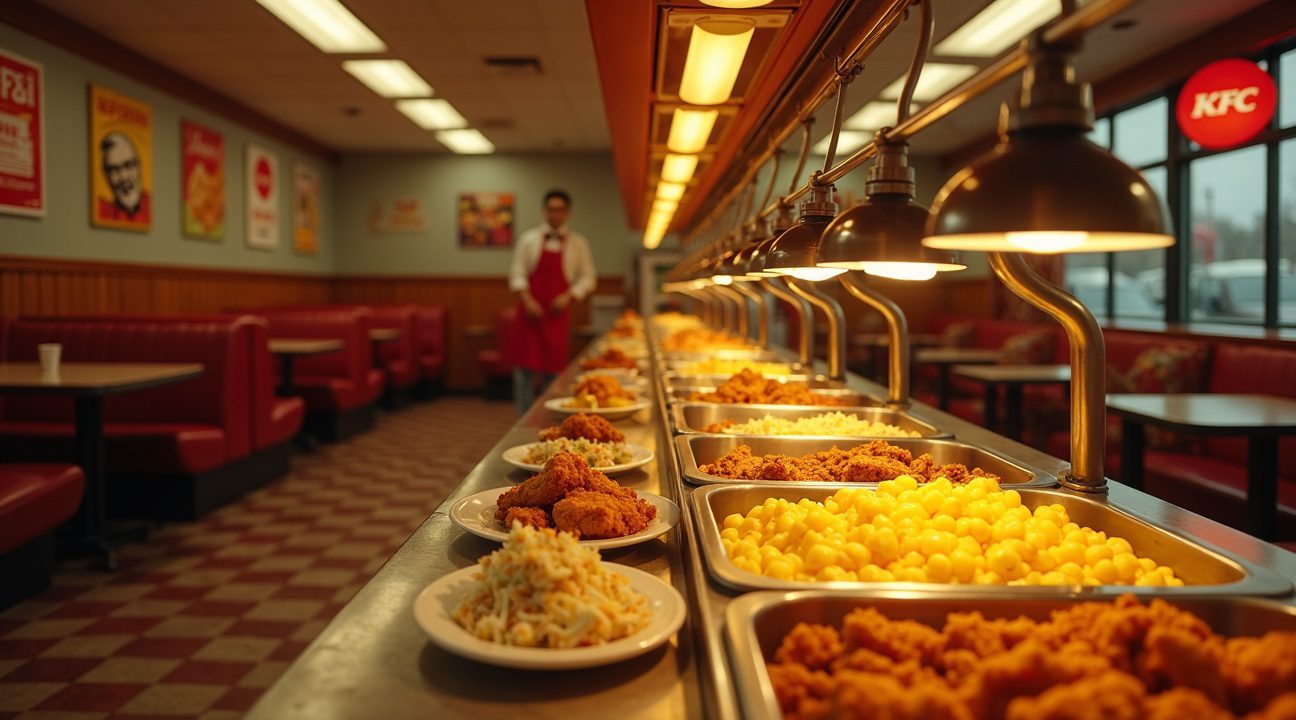
What’s Actually on a KFC Buffet: Beyond Just Fried Chicken
Walking into a KFC buffet reveals a spread that goes far beyond what most people expect from the famous chicken chain. The centerpiece remains the Original Recipe Fried Chicken, with its iconic blend of 11 herbs and spices that made Colonel Sanders famous. However, the buffet format transforms the typical fast-food experience into something more comprehensive.
The sides selection forms the real backbone of these buffets, offering comfort food classics that complement the signature chicken perfectly:
- Creamy mashed potatoes topped with rich brown gravy create a satisfying foundation for any plate.
- Fresh coleslaw provides a crisp contrast to the heavier items.
- Buttery corn kernels add sweetness to balance the savory elements.
- Warm, flaky biscuits appear fresh throughout service hours.
- Hearty baked beans round out the traditional Southern-style offerings.
Regional Variations and Seasonal Additions
Canadian locations and select American franchises often expand their buffet selections based on regional preferences and seasonal availability. These variations might include:
- Creamy mac and cheese, increasingly popular at certain locations.
- Green beans, offering a vegetable option for health-conscious diners.
- Rotating special items during holidays or promotional periods.
The dessert section varies significantly by location but commonly features simple options like chocolate or vanilla pudding. Soft-serve ice cream machines appear at many locations, allowing customers to create their own small sundaes or simply enjoy a cool finish to their meal.
What makes the buffet format particularly appealing is the freedom it provides customers to experiment without financial pressure. Instead of committing to specific pieces or combo meals, diners can sample small portions of multiple items. This approach proves especially valuable for families with varying tastes or individuals curious about menu items they’ve never tried.
The all-you-can-eat structure also eliminates the common frustration of ordering too little food:
- Customers can return for seconds of their favorites.
- People can try items they initially skipped.
- The buffet introduces diners to traditional Southern comfort food, like biscuits and gravy.
Many locations maintain their buffets during peak hours, typically lunch and early dinner periods when foot traffic justifies the continuous preparation required. The constant turnover ensures freshness, with items replenished regularly throughout service. Staff members monitor the buffet closely, replacing items that have sat too long and maintaining proper temperatures for food safety.
The Devoted Fans Keeping KFC Buffet Dreams Alive
I’ve discovered that passionate fans across social media platforms work tirelessly to preserve everything about KFC buffets. Facebook groups and online forums serve as digital headquarters for these dedicated enthusiasts who refuse to let buffet culture fade away. They’ve created detailed databases of remaining locations, compile comprehensive reviews, and coordinate group trips to experience these rare dining gems together.
Community-Driven Documentation and Celebration
The Facebook group KFC Buffet Aficionados stands out as particularly active in maintaining current location lists and sharing vital information. Members of this community treat each discovery like finding treasure, posting photos and detailed reviews that help others plan their visits. I’ve noticed how these groups celebrate major wins – when a KFC buffet reopens after closure or when someone discovers a previously unknown location, the excitement spreads like wildfire through social media channels.
Nostalgia drives much of this enthusiasm, with participants frequently sharing childhood memories of family visits and special occasions centered around KFC buffets. These personal stories create emotional connections that extend far beyond simple restaurant reviews. Parents describe introducing their own children to buffets they remember from decades past, while others share photos from birthday parties and family gatherings held at these locations.
The dedication goes beyond casual interest – these fans actively organize road trips to visit distant buffets, sometimes traveling hundreds of miles for the experience. They document everything from menu variety to restaurant atmosphere, creating comprehensive guides that help newcomers understand what makes each location unique.
- Menu offerings and photos
- Interior design and layout
- Customer service experiences
- Pricing and local specials
Some members have visited dozens of different KFC buffets across multiple states, turning their passion into extensive documentation projects.
These online communities also serve as early warning systems when buffets face closure threats or undergo renovations. Members quickly share updates about schedule changes, temporary closures, or permanent shutdowns, allowing fellow enthusiasts to make final visits or adjust travel plans accordingly. The collective knowledge within these groups often surpasses official company information, making them invaluable resources for anyone seeking authentic KFC buffet experiences.
Through their persistent efforts, these devoted fans ensure that KFC buffet culture continues thriving despite corporate shifts away from the format. Their documentation preserves not just location data but the entire experience – from describing specific dishes available to capturing the unique atmosphere that makes these establishments special. Meanwhile, entertainment news continues evolving in different directions, much like how Netflix announces new anime series to capture audience attention in streaming markets.
https://www.youtube.com/watch?v=Lwkrdi3om1I
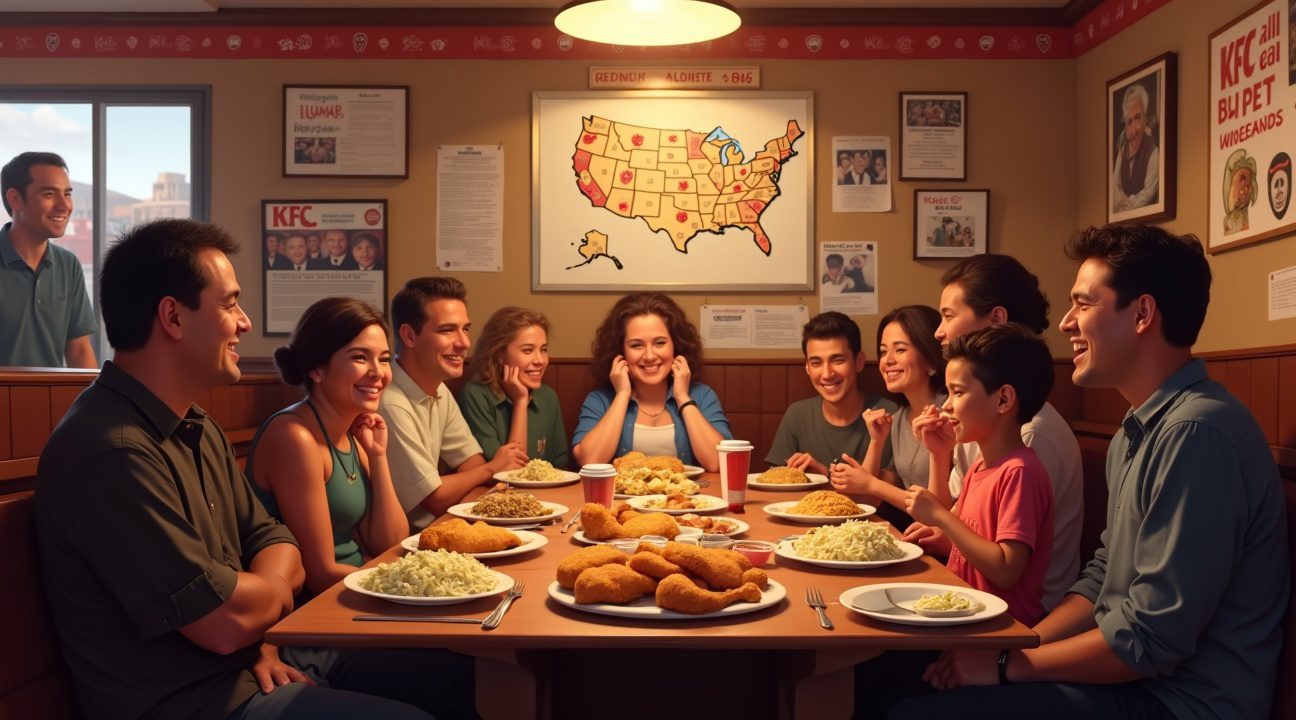
Sources:
Mashed – “KFC Buffet Locations: Here’s Where You Can Find Them”
The Daily Meal – “Where to Find the Remaining KFC Buffet Locations”
The Daily Meal – “Whatever Happened to the KFC Buffet?”
Foodie – “KFC Buffet Locations Totally Discontinued”
Statista – “Number of Kentucky Fried Chicken restaurants worldwide”
Wikipedia – “List of countries with KFC franchises”

